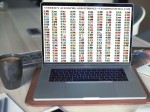Day Trading Style:
To be a successful day trader, you need to commit yourself in front of your computer in order to manage your trades. You will also be required to make quick decisions getting in and out quickly, probably a number of times during the day you trade. Therefore, as a day trader, you must love a lot of action, thrills and excitement. You will most likely have several losses and several profits during the trading day, but your goal is to come up with more profits than losses by the end of the day.
Sometimes, it is possible for the day trader to have more losing trades than winning trades and still come up with a profit at the end of the trading day. This is because one big winning can sometimes compensate many smaller losses.
One advantage of Day trading style is that you wouldn’t have to worry about the market overnight since your trades end on the same day.
Day trading style demands the most complex of financial services and financial investment instruments in order to become successful.
Because day traders have to close their positions within the trading day, then they will need to have instantaneous access to the trading desk so they can place and close positions to acquire profit. Unfortunately, instantaneous order executions are reserved only for traders working with larger institutions and are trading large amounts of money.
Day traders will also need multiple news sources and analytical software. Stand-alone trading software is an expensive necessity for day traders. It incorporates automatic pattern recognition, genetic and neural applications, back testing of trading strategies and sometimes, and trading news. The good thing is that there are already several brokers which provide traders with free Forex trading software with broker integration for instantaneous transactions.
Although Day trading style is one of the popular ways to trade in the forex market, it is not for everyone. You can try it one day and see for yourself. If you love the action, excitement and thrills, you may be suited for day trading. Otherwise, choose a different trading style.
Swing Trading Style:
Swing trading is normally carried out between support and resistance levels within the major trend:
- Support levels are horizontal lines that define the price at which traders think that the prices will move higher,
- While resistance levels are horizontal lines that define the upper level at which traders think that the currency price will drop: It is the point where there are more sellers than buyers.
A common strategy in forex trading uses the support and resistance levels to determine when and how to issue limit orders: Take-profit orders and Stop-loss orders.
For swing trading, good liquidity is important and any currency that does not provide good liquidity should be avoided.
Good currencies to trade in Swing Trading Style are:
Swing trading is a strategy which requires high risk in order to get high rewards. In order to be successful, a swing trader must choose appropriate currency pairs (or stocks, depending on which assets are being traded), typically those which are most actively traded. They must be in the high and low extremes, those which are bound for a reversal.
- Euro,
- Yen,
- British Pound,
- Swiss Franc,
- Canadian
- and Australian Dollar.
Among these, the Euro and the Japanese Yen are the two best currencies to trade as they offer great volatility and large volumes with tight spreads.
Position Trading Style:
When the price goes up, most traders are often tempted to bank it prematurely, and by doing so, they may be making much smaller marginal profit when they could have had a huge profit. On the other hand, when the price drops and your open equity starts diminishing, sometimes by thousands of dollars quickly, most traders would panic and try to stop the loss by selling prematurely; thereby, missing out on the opportunities to win big profits.
For these reasons, Position Trading Style is probably the most difficult trading style to master and it is advisable for novice Forex traders to avoid the long-term position trading.
Day Trading Style vs Swing Trading Style: Which One To Choose?
The difference between Day Trading Style and Swing Trading Style is attributed to the length of time a position is held.
As specified above, the Day trading style refers to the buying and selling of a currency within a single trading day. Traders take advantage of the small price movements in highly volatile currencies in order to make profit. On the other hand, Swing trading style is fundamental in nature because traders usually hold their positions for several days waiting for sufficient price movement that result in a relatively substantial profit. Trading typically happens intra-week and will depend on the optimism and pessimism in the market.
Many professional money managers shy away from Day trading because they believe that the reward for such strategies does not commensurate the risk they have to endure. Yet, there are those who insist that there is profit to be made and the low success rate can be related to the increased complexity of day trading, the necessary risk and the related scams which promote day trading as a get-rich-quick scheme.
Swing traders are also reliant on the right market. Trading in a raging bear or bull market can be challenging for a swing trader because the values of assets are carried on the long term in one direction (typically lasting for a few months). In this case, the trader’s resources are tied up for longer periods of time, thereby increasing the opportunity cost. The best time for swing trading is when the market is going nowhere: "when the rates rise for a couple of days then decline for the next few days and repeat the opposite pattern again and again".
The challenge for the swing trader is to determine which currencies and markets are in between the extremes. They have to catch the pattern early so that they can profit on the reversal. For this, they will need to get baseline data and daily or weekly charts so as to analyze the direction of the currency and whether there is a possibility that asset values will rise or fall soon.


















